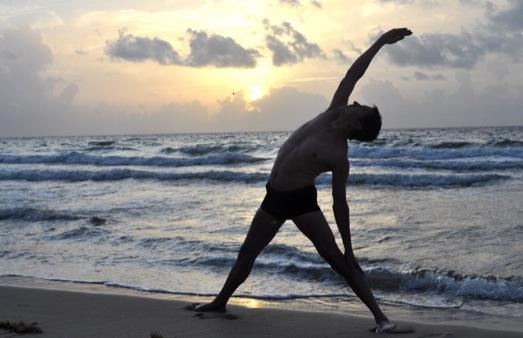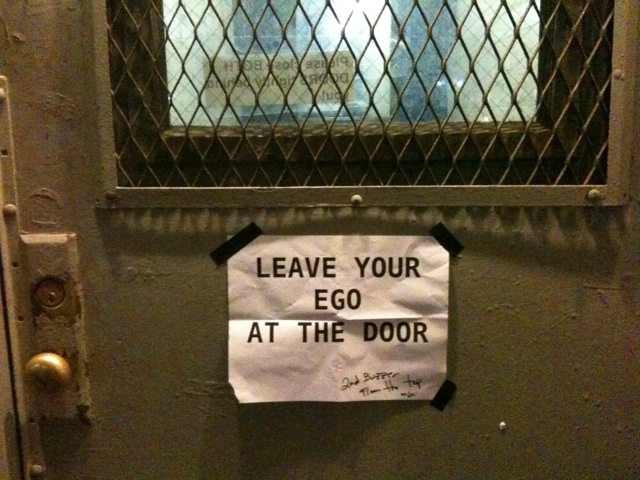Hatha yoga has changed my life so much for the better during the past 15 years.
I have diligently practiced it, studied it and even have become a certified instructor.
I am more connected with myself and other people, I am more spiritual, my general level of health and well-being seems better and overall I feel less stress. I am a happier person.
On the other hand, some of the worst injuries I have experienced in my life have occurred during my practice, including a torn medial meniscus in my left knee and a torn supraspinatus tendon in my left shoulder, both of which required expensive surgery and moderately long recovery periods.
Hatha yoga, literally translated means forceful or violent yoga, refers to an ancient branch of yoga that incorporates breathing and physical movements of the body.
Keep in mind the intent behind this practice was to help calm the random chatter of the mind in order to prepare the body and mind for meditation.
During the past twenty years, Hatha yoga has experienced double-digit growth rates of practitioners world-wide, and the revenues of most studios are increasing yearly. Famous gurus and teachers such as Bikram Choudury, Baron Baptiste, Jimmy Barkan, John Friend,T.K.V. Desikachar, Lilias Folan, B.K.S. Iyengar, Sri K. Pattabhi Jois, Sri T. Krishnamacharya, Rodney Yee, Shiva Rae and others have all contributed, with their own unique styles and philosophies, to the surge in popularity of Hatha Yoga.
In today’s world of instant information, we all feel pressure to achieve more in less time. In this atmosphere of almost instant gratification, we fall victim to the myriad advertisements and articles promoting the perfect exercise, yoga included, to give us that perfect body and that perfect state of mind—blissful happiness.
My belief is that Hatha yoga can guide you to a heightened awareness about yourself and your body. On such a path, you will discover ways, unique to you, to become more balanced, more centered, more grounded, all of which will lead you to a healthier, happier lifestyle.
Understanding and incorporating the following five principles will help you to prevent injuries in your Hatha yoga journey.
1: No Pain, No Gain? No Way!
During the first 40 years of my life I was a competitive swimmer, triathlete and long-distance runner. I spent countless hours working out in gyms and cross-fit programs, always incorporating that golden rule of training: No Pain, No Gain.
Now I know that rule is simply bullshit. It is just not true.
Any muscle, tendon, ligament or bone in pain is one that is injured. It is that simple. Once you injure yourself, your body must use resources to repair the injury. Why is this good? It is not good—ever.
The best and healthiest exercises for your body promote strong ligaments, bones, tendons and muscles so that your joints move in a stable and comfortable range of motion.
A mindful Hatha Yoga practice is a great way to achieve this.
The study and science of muscle physiology is dynamic and our understanding of exactly how muscles work and grow is improving. There are four basic types of muscle contractions currently known: concentric (bicep curl), eccentric (quadriceps in walking), isometric (carrying an object in your hands) and passive stretching (hamstrings as you touch your toes).
Whatever type of contraction occurs in our muscles, if you subject them to a force greater than they are capable of withstanding, they will tear or the force will transfer from the muscle and injure a tendon or ligament. And yes, you will feel pain. Now, tell me, where is the gain in this?
So the next time you are in a yoga class and the instructor, let’s call her Sargent Stephanie, yells out during a standing back bend: “Go back, way, way back. It’s gonna hurt like hell, but do it,” just smile, breathe deeply into your back bend and stop when your body tells you that you’ve gone far enough. There is no room for pain in your back bends! There is no room for pain in a mindful Hatha Yoga practice.
2: Just Say No to Adjustments
We always caution our children to never let anyone touch them in certain places. Well guess what? The same goes for anyone practicing Hatha yoga.
Never let an instructor or even a world-famous guru forcefully move any part of your body in such a manner that you feel any stress or pain!
I simply have a “hands off” policy, period. No longer do I touch students, and I definitely, but politely, let instructors know to keep their hands off me.
It is okay if an instructor asks you to move your body into or toward their hand because you are using your own muscular force and range of motion to do this. I use this technique occasionally among my students. But, again, never move into a position where you feel undue stress or pain in your body.
One of the most persistent and longest occurring injuries I ever sustained in yoga was at a Bikram studio in Key West, Florida. I was doing the seated patahastansana and was in as deep as I could go when an over-zealous and undereducated instructor came up to me, squatted down and forcefully pulled my elbows toward the ground. Immediately, I could feel one of the hamstring muscles in my left leg tear.
It took me five years to recover from that one adjustment.
3: Check Your Ego At The Door
This is by farthe hardest concept for me to accept and to practice. From my experience as an instructor, I know this is extremely difficult for many of my students, too.
When I use the term ego,I am referring to the concept of self-importance and self-esteem. I do not mean to imply that these are bad things, but they have no place in a Hatha yoga practice. If you bring them into the yoga room, you will fall into a routine of constantly comparing yourself and your ability to achieve a certain “perfect pose” with everyone else in the room. This is not yoga.
It is important to understand that all the Hatha yoga asanas represent just one point in time in a flow of joint movements into and out of a particular set of bone alignments.
No two people are built exactly the same, therefore no two people will have the same exact endpoint of any asana.
Don’t fall prey to the lure of models on the cover of so many popular yoga periodicals—young women with Barbie Doll figures, perfect white teeth, and text-book alignment of difficult asanas.
Two of my worst yoga injuries occurred when I succumbed to my ego.
The first occurred four years ago when I attended Jimmy Barkan’s Level II/III teacher training. I let my ego get in the way of my practice. Perhaps that occurred because I was having trouble resolving how my life seems to march on relentlessly the older I get.
There were many younger people there, and, at 51 years old, I tried to keep up with them. We attended two 90-minute hot yoga classes daily, and I was having trouble keeping well hydrated. Toward the end of a long class, Jimmy was demonstrating how to get into some of the more advanced asanas. I should have observed, but, spurred on by the youth around me, I kept going. Just as I got into a pose called bamanasana, (basically a deep lotus pose but standing on one knee), I felt something give way in my left knee. I knew immediately I had torn a meniscus. Two months later, I had to have surgery.
And yet, even after that, I more recently fell into bringing my ego into the yoga room.
For the past four years I have developed a loyal following of students who like hot vinyasa flow. I became known as a good but challenging instructor—my students pushed me to create more difficult flows. Sometimes my classes would swell to 40 students, and I relished in the glory of being able to kick the butts of young adults half my age.
About two years ago, my shoulders, first the right, then the left, began to ache at night, often disturbing my sleep. I didn’t listen. I thought my body was just adjusting to all the arm balances, chaturangas (push ups), and handstands I had incorporated into what had become known as my “Power Hour” classes.
Eventually, I went to an orthopedic surgeon who diagnosed me with tendonitis and advised me to stop all the intense shoulder use. I didn’t listen. I kept rocking with my students, seeking to push that envelop, ignoring everything I knew deep inside myself to be true.
Finally, the brachial plexus nerves in my left shoulder rebelled and became inflamed. I tore the supraspinatus tendon in my left shoulder without knowing it, and one morning last March I woke up and could not move my left arm.
Thank you ego. Thank you obstinacy. Thank you for not listening.
I have not been able to teach since March, and I am in recovery from having rotator cuff surgery on my left shoulder seven weeks ago.
I believe I finally understand this ego thing.
I am pleased to say that I started back my own individual Hatha yoga practice this week. I will be a different teacher when I return to my students next year.
4: Props & Modifications Are Good
Props (blocks, straps, bolsters, and blankets) in yoga are simply extensions of our body parts or objects used to support body parts.
I have never understood disciplines such as Bikram yoga that discourage and even prohibit props.
Because we all have different lengths of bones, it may be impossible for someone to get into correct alignment in a certain asana without a prop. It does not take a rocket scientist to figure this one out!
Props such as blankets, bolsters and straps are essential in the initial undertaking of many asanas. Depending on the structure of your body and muscles, you may eventually move into the asana without a prop or you may not. The point is, it does not matter so long as you are in correct alignment.
My advice is to stay away from studios where props are not allowed and stay away from instructors who do not use them.
5: It’s All About You; It’s All About Your Breath
Despite my alert about checking your ego at the door in number three above, your Hatha yoga practice is all about you as an individual. But in this sense I refer to your individual knowledge of yourself, not yourself compared to others.
And you are nothing without your breath. What is the first thing you do when you are born? Take your first breath. What is the last thing you do when you die? Take your last breath.
Hatha yoga is using your breath to get your body into certain alignments (asanas). Getting to know how your breath and muscles work together forces your mind to focus, to forget the constant chatter of the brain. This, in turn, helps you to connect with yourself and in turn, connect with your spirit and the universe.
My biggest strides in my Hatha yoga practice have occurred effortlessly when I adhered to the five principles I described above. In doing so, I progressed deeper into my breath, into my body, into my asanas, and ultimately into a meditative state where I am best able to connect with my spirit and all of that which is our universe.
I believe a consistent, mindful Hatha yoga practice is a good thing for most people who have been seeking ways to become healthier, happier and better connected to themselves and others.
~
Love elephant and want to go steady?
Sign up for our (curated) daily and weekly newsletters!
Editor: Catherine Monkman
Photo: Courtesy of the author, flickr













Read 9 comments and reply